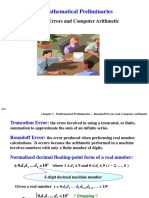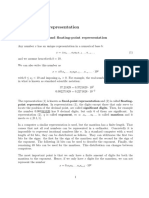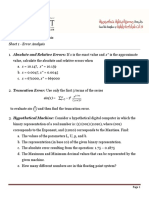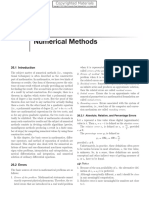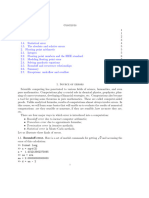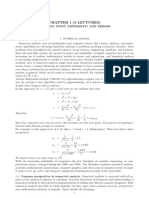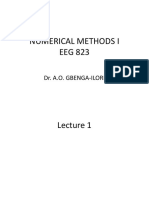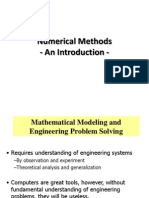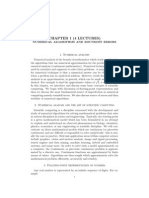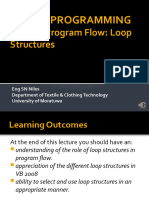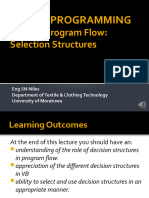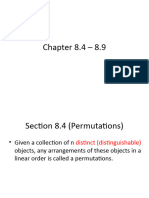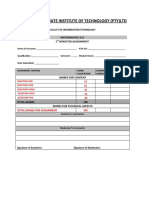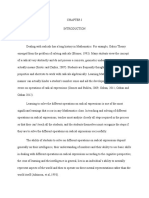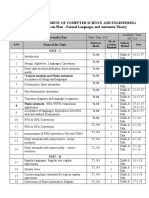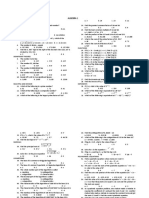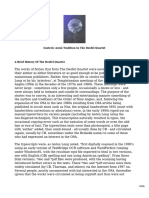In20 S2 MA1024
1 Approximations and Errors
1.1 Round-Off Errors
• The error that is produced when a calculator or computer is used to perform real number
calculations is called round-off error.
• Real numbers are typically represented in computers using floating-point form.
1.2 Machine Numbers
• Machine numbers are represented in the normalized decimal floating-point form
± 0.d1 d2 . . . dk × 10n , 1 ≤ d1 ≤ 9, and 0 ≤ di ≤ 9, (1.1)
for each i = 2, . . . , k. Numbers of this form are called k-digit decimal machine num-
bers.
• Any positive real number can be normalized to the form
y = 0.d1 d2 . . . dk dk+1 dk+2 · · · × 10n (1.2)
• The floating-point form of y, denoted f l(y), is obtained by terminating the mantissa of y
at k decimal digits. There are two common ways of performing this termination.
– chopping: chop off the digits dk+1 dk+2 . . . to produce the floating-point form
f l(y) = 0.d1 d2 . . . dk × 10n (1.3)
– rounding: when dk+1 ≥ 5, add 1 to dk to obtain f l(y); when dk+1 < 5, chop off all
but the first k digits. Here the floating-point has the form
f l(y) = 0.δ1 δ2 . . . δk × 10n (1.4)
1.3 Measuring Errors
• Suppose that p∗ is an approximation to p. The absolute error is |p − p ∗ |, and the
p − p∗
relative error is , provided that p 6= 0.
p
1.4 Finite-Digit Arithmetic
• The arithmetic performed in a computer is not exact.
• Assume that the floating-point representations f l(x) and f l(y) are given for the real
numbers x and y and that the symbols ⊕, , ⊗, represent machine addition, subtraction,
multiplication, and division operations, respectively.
x⊕y = f l(f l(x) + f l(y)) (1.5)
x y = f l(f l(x) − f l(y)) (1.6)
x⊗y = f l(f l(x) × f l(y)) (1.7)
x y = f l(f l(x)/f l(y)) (1.8)
• Accuracy loss due to round-off error can also be reduced by rearranging calculations.
example 1.1 ex − e−x
Let f (x) = . Use four-digit rounding arithmetic to evaluate f (0.1).
x
1 UoM
� In20 S2 MA1024
1.5 Truncation Error and the Taylor Series
• Truncation errors are the errors that result from using approximation in place of an exact
mathematcal procedure.
• The mathematical formulation that is used extensively in numerical methods to approx-
imate functions is the Taylor series.
Theorem 1.1 – Taylor’s Theorem. Suppose f ∈ C n [a, b], that f (n+1) exists on [a, b], and
x0 ∈ [a, b]. For every x ∈ [a, b], there exists a number ξ(x) between x0 and x with
f (x) = Pn (x) + Rn (x), (1.9)
where
f 00 (x0 ) f (n)
Pn (x) = f (x0 ) + f 0 (x0 )(x − x0 ) + (x − x0 )2 + · · · + (x0 )(x − x0 )n
2! n!
n
f (k) (x0 )
(x − x0 )k
X
= (1.10)
k=0 k!
and
f (n+1) (ξ(x))
Rn (x) = (x − x0 )n+1 (1.11)
(n + 1)!
Here Pn (x) is called the nth Taylor polynomial for f about x0 , and Rn (x) is called the
remainder term (or truncation error) associated with Pn (x).
example 1.2 (i) Find the nth Taylor polynomial of the function f (x) = ex about x0 =
0.
(ii) Approximate e0.5 within the accuracy 10−3 .
1.6 Algorithm and Convergence
• An algorithm is a set of well-defined instructions to solve a particular problem.
• If a small changes in the initial data produce correspondingly small changes in the final
results then the algorithm is stable; otherwise it is unstable.
• Some algorithms are stable only for certain choices of initial data, and are called condi-
tionally stable.
Definition 1.1. Suppose that E0 > 0 denotes an error introduced at some stage in the calcu-
lations and En represents the magnitude of the error after n subsequent operations.
• If En ≈ CnE0 , where C is a constant independent of n, then the growth of error is said
to be linear.
• If En ≈ C n E0 , for some C > 1, then the growth of error is called exponential.
2 UoM
� In20 S2 MA1024
Figure 1.1
Definition 1.2 – Rate of Convergence. Suppose {βn }∞ n=1 is a sequence known to converge to
∞
zero, and {αn }n=1 converges to a number α. If a positive constant K exists with
|αn − α| ≤ K|βn |, for large n,
then we say that {αn }∞ n=1 converges to α with rate, or order, of convergence O(βn ). (This
expression is read ”big oh of βn ”.) It is indicated by writing αn = α + O(βn ).
0
REFERENCES
(i) Numerical Analysis, Richard L. Burden, J.Douglas Faires.
(ii) Numerical Methods for Scientific and Engineering Computation, M.K. Kain, S.R.K. Iyenger, R.K. Jain
3 UoM

